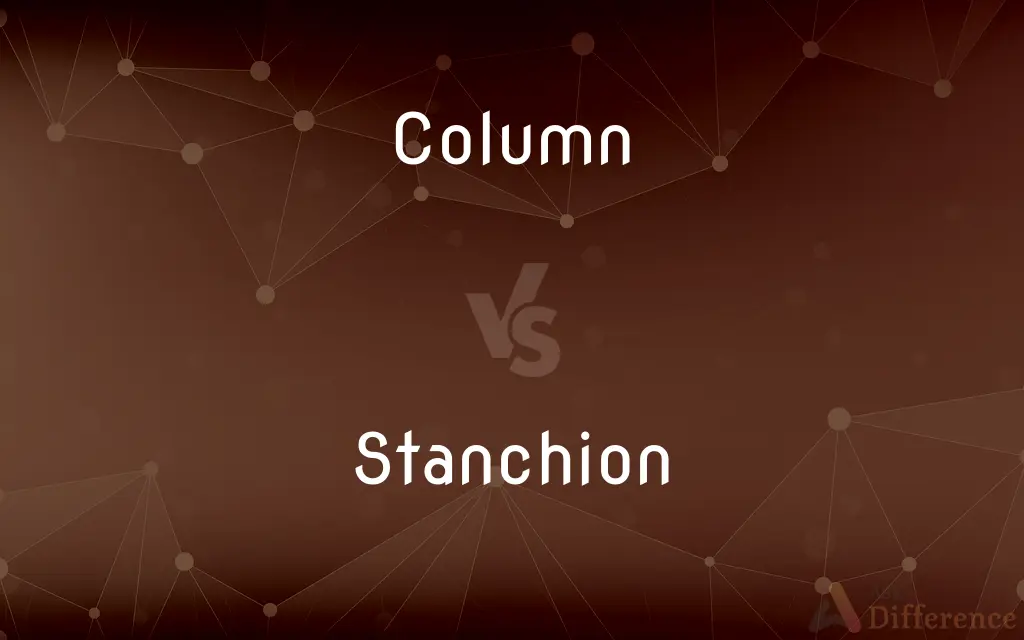Column vs. Stanchion — What's the Difference?
By Tayyaba Rehman & Maham Liaqat — Updated on April 26, 2024
Column primarily supports vertical loads in structures, such as buildings, while a stanchion provides support or barriers in various contexts like events or industrial settings.

Difference Between Column and Stanchion
Table of Contents
ADVERTISEMENT
Key Differences
Columns are structural elements primarily designed to support vertical loads and transfer these loads to the foundation, typically used in buildings and other large structures. On the other hand, stanchions are often used to support or separate in lighter applications, such as guiding traffic or as barriers in queues.
Columns are usually permanent architectural or structural features made from materials like stone, concrete, or steel, designed to support significant weight. Whereas stanchions are typically temporary and portable, made from lighter materials like plastic or steel tubing, and are not meant for heavy structural support.
In architecture, columns are integral to the aesthetic and structural integrity, contributing to both the interior and exterior design of a building. Conversely, stanchions are functional and utilitarian, often used in public spaces to manage crowds or traffic without any architectural significance.
Columns come in various classical orders which include Doric, Ionic, and Corinthian, each with unique decorative styles. On the other hand, stanchions are more about functionality than style, usually featuring a simple, straightforward design.
While columns are often seen as symbols of strength and durability in construction, stanchions are valued for their flexibility and mobility, used for temporary setups and easily adjustable configurations.
ADVERTISEMENT
Comparison Chart
Primary Use
Support vertical loads
Provide support or barriers
Material
Stone, concrete, steel
Plastic, light metal
Installation
Permanent, fixed
Temporary, portable
Structural Importance
High, critical for load-bearing
Low, not for heavy loads
Design
Aesthetic elements, various styles
Utilitarian, minimalistic design
Compare with Definitions
Column
A regular vertical arrangement of figures or other information.
We added a new column to the spreadsheet for additional data.
Stanchion
Used to create lanes or enclosures, often seen in banks or airports.
Stanchions with retractable belts guided passengers at the airport.
Column
A column or pillar in architecture and structural engineering is a structural element that transmits, through compression, the weight of the structure above to other structural elements below. In other words, a column is a compression member.
Stanchion
An upright bar, post, or frame forming a support or barrier.
Stanchions were set up to control the crowd at the concert.
Column
A vertical structure usually consisting of a base, a cylindrical shaft, and a capital, used as a support or standing alone as a monument.
Stanchion
A support for a railing, often used on ships or in industrial settings.
The deck’s safety was ensured by adding more stanchions to the railings.
Column
Any slender vertical support, as of steel or reinforced concrete.
Stanchion
A structural element used in certain types of construction to support shelving or other components.
The warehouse aisles were organized using metal stanchions.
Column
Something resembling an architectural column in form or function
A column of mercury in a thermometer.
Stanchion
A post of timber, steel, or other materials set upright as a support.
Temporary stanchions were used during the building’s renovation.
Column
One of two or more vertical sections of text lying side by side in a document and separated by a rule or a blank space.
Stanchion
A stanchion () is a sturdy upright fixture that provides support for some other object. It can be a permanent fixture.
Column
An arrangement of numbers in a single vertical line.
Stanchion
An upright pole, post, or support.
Column
A feature article that appears regularly in a publication, such as a newspaper.
Stanchion
A framework consisting of two or more vertical bars, used to secure cattle in a stall or at a feed trough.
Column
A formation, as of troops or vehicles, in which all elements follow one behind the other.
Stanchion
To equip with stanchions.
Column
(Botany)A columnlike structure, especially one formed by the union of a stamen and the style in an orchid flower, or one formed by the united staminal filaments in flowers such as those of the hibiscus or mallow.
Stanchion
To confine (cattle) by means of stanchions.
Column
(Anatomy)Any of various tubular or pillarlike supporting structures in the body, each generally having a single tissue origin and function
The vertebral column.
Stanchion
A vertical pole, post, or support.
Column
(architecture) A solid upright structure designed usually to support a larger structure above it, such as a roof or horizontal beam, but sometimes for decoration.
Stanchion
A framework of such posts, used to secure or confine cattle.
Column
A vertical line of entries in a table, usually read from top to bottom.
Stanchion
To erect stanchions, or equip something with stanchions.
Column
A body of troops or army vehicles, usually strung out along a road.
Stanchion
To confine by means of stanchions, typically used for cattle.
Column
A body of text meant to be read line by line, especially in printed material that has multiple adjacent such on a single page.
It was too hard to read the text across the whole page, so I split it into two columns.
Stanchion
A prop or support; a piece of timber in the form of a stake or post, used for a support or stay.
Column
A unit of width, especially of advertisements, in a periodical, equivalent to the width of a usual column of text.
Each column inch costs $300 a week; this ad is four columns by three inches, so will run $3600 a week.
Stanchion
Any upright post or beam used as a support, as for the deck, the quarter rails, awnings, etc.
Column
(by extension) A recurring feature in a periodical, especially an opinion piece, especially by a single author or small rotating group of authors, or on a single theme.
His initial foray into print media was as the author of a weekly column in his elementary-school newspaper.
Stanchion
A vertical bar for confining cattle in a stall.
Column
Something having similar vertical form or structure to the things mentioned above, such as a spinal column.
Stanchion
Any vertical post or rod used as a support
Column
(botany) The gynostemium
Column
(chemistry) An object used to separate the different components of a liquid or to purify chemical compounds.
Column
A kind of pillar; a cylindrical or polygonal support for a roof, ceiling, statue, etc., somewhat ornamented, and usually composed of base, shaft, and capital. See Order.
Column
Anything resembling, in form or position, a column in architecture; an upright body or mass; a shaft or obelisk; as, a column of air, of water, of mercury, etc.; the Column Vendôme; the spinal column.
Column
A body of troops formed in ranks, one behind the other; - contradistinguished from line. Compare Ploy, and Deploy.
Column
A number of ships so arranged as to follow one another in single or double file or in squadrons; - in distinction from "line", where they are side by side.
Column
A perpendicular set of lines, not extending across the page, and separated from other matter by a rule or blank space; as, a column in a newspaper.
Column
A perpendicular line of figures.
Column
The body formed by the union of the stamens in the Mallow family, or of the stamens and pistil in the orchids.
Column
One of a series of articles written in a periodical, usually under the same title and at regular intervals; it may be written and signed by one or more authors, or may appear pseudonymously or anonymously, as an editorial column.
Column
A line of (usually military) units following one after another
Column
A vertical glass tube used in column chromatography; a mixture is poured in the top and washed through a stationary substance where components of the mixture are adsorbed selectively to form colored bands
Column
A linear array of numbers one above another
Column
Anything tall and thin approximating the shape of a column or tower;
The test tube held a column of white powder
A tower of dust rose above the horizon
A thin pillar of smoke betrayed their campsite
Column
An article giving opinions or perspectives
Column
A vertical structure standing alone and not supporting anything (as a monument or a column of air)
Column
(architeture) a tall cylindrical vertical upright and used to support a structure
Column
A vertical structural element that transmits the weight of the structure above to other structural elements below.
The ancient Greeks designed columns that are still admired for their architectural beauty.
Column
An upright pillar, typically cylindrical and made of stone or concrete, supporting an entablature.
Each column in the old courthouse was carefully restored during the renovation.
Column
A vertical division of a page or text.
The newspaper featured several columns dedicated to international news.
Column
A formation of ships, troops, or vehicles in line abreast.
The soldiers marched in a column during the parade.
Common Curiosities
How is a stanchion most commonly used?
As a support or barrier in settings that require crowd control or temporary enclosures.
What is the primary structural function of a column?
To support vertical loads and distribute weight in buildings and other structures.
What is the typical installation process for a stanchion?
Stanchions are typically easy to install and move, often involving simple mounting or freestanding setups.
Can columns be considered decorative architectural elements?
Yes, columns often serve both structural and decorative purposes, especially in classical architecture.
What is the historical significance of columns in architecture?
Columns have a rich historical significance, dating back to ancient civilizations like Greece and Rome, symbolizing strength and beauty.
What materials are commonly used to make columns?
Stone, concrete, and steel are the most common materials.
Are stanchions designed to be permanent or temporary?
Stanchions are usually designed to be temporary and portable.
Are columns found in modern architecture?
Yes, columns are prevalent in both ancient and modern architectural designs.
How do the functions of columns and stanchions differ in industrial settings?
In industrial settings, columns are used to support structures, while stanchions might be used to support lightweight fixtures or as safety barriers.
How does the material choice affect the function of columns and stanchions?
Material choice is crucial; heavier materials like stone and steel are used for columns to support significant weights, whereas lighter materials are sufficient for stanchions.
How does the design of columns contribute to architectural style?
The design of columns can define an architectural style, with different orders and decorations reflecting specific historical and cultural aesthetics.
What types of designs are stanchions typically available in?
Stanchions typically have a simple, functional design focused on utility rather than aesthetics.
Do stanchions handle heavy loads?
No, stanchions are not designed for heavy structural support but more for guiding or blocking.
Can stanchions be used for safety purposes?
Yes, stanchions can be used to create safe barriers in various environments, including construction sites and public spaces.
Are there specific environments where stanchions are especially useful?
Stanchions are particularly useful in crowded public spaces like airports, concert venues, and museums to manage the flow of people.
Share Your Discovery

Previous Comparison
Offsite vs. Onsite
Next Comparison
Attention vs. CareAuthor Spotlight
Written by
Tayyaba RehmanTayyaba Rehman is a distinguished writer, currently serving as a primary contributor to askdifference.com. As a researcher in semantics and etymology, Tayyaba's passion for the complexity of languages and their distinctions has found a perfect home on the platform. Tayyaba delves into the intricacies of language, distinguishing between commonly confused words and phrases, thereby providing clarity for readers worldwide.
Co-written by
Maham Liaqat











































